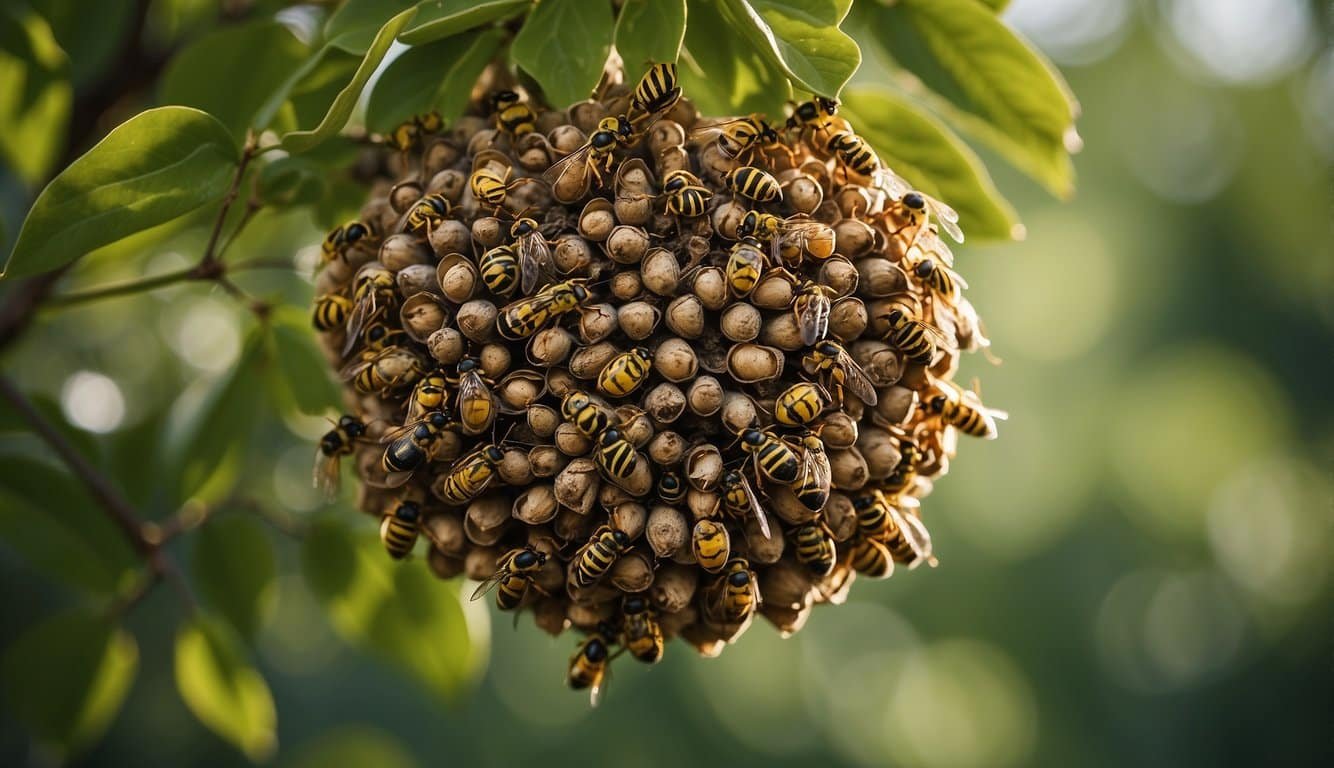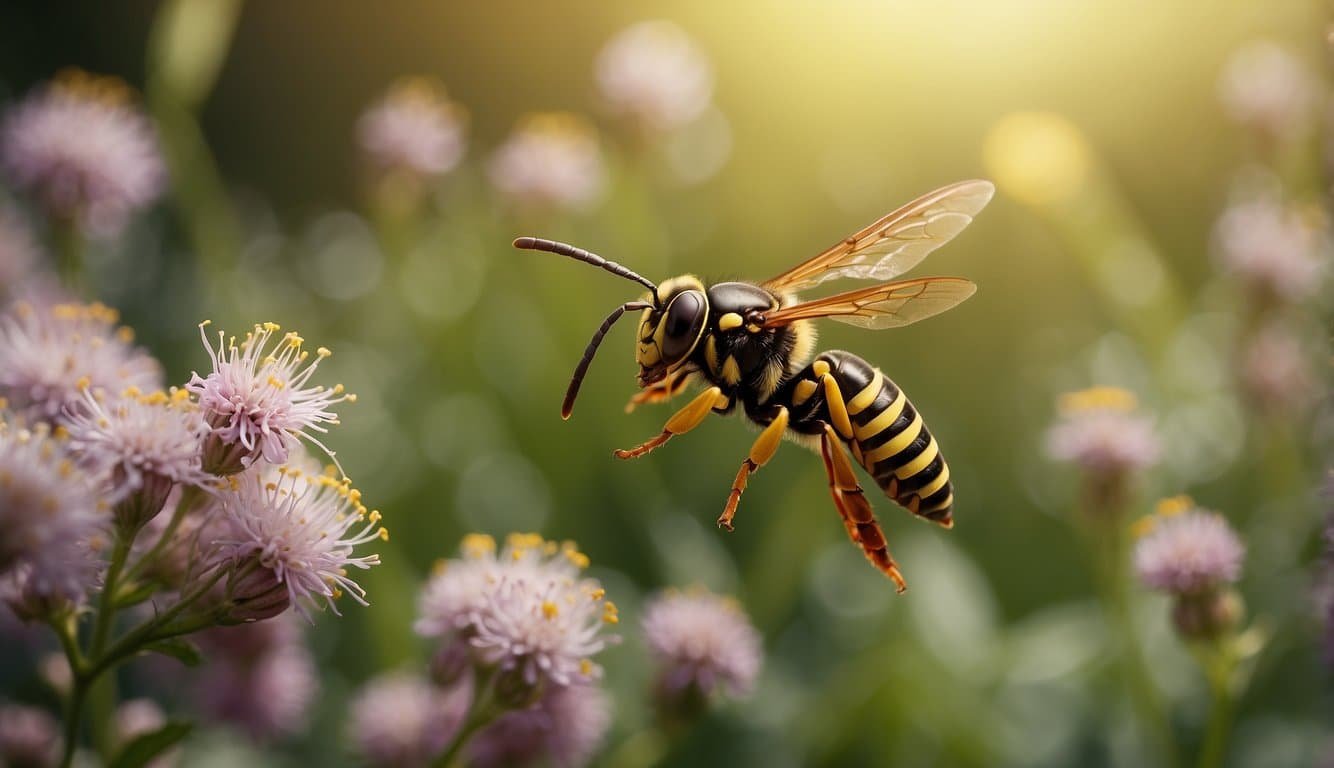Wasps Overview
Wasps, with their striking presence, play various roles in our ecosystem, from pollinators to predators. This section explores the taxonomy, distinct physical traits, and diverse behaviors that characterize these fascinating insects.
Wasp Classification
Wasps fall under the order Hymenoptera, which includes over 150,000 described species. This order also encompasses bees and ants. Within wasps, there is a complex hierarchy divided into families such as Vespidae and Pompilidae. They are further classified into categories like social wasps such as yellowjackets and hornets, solitary wasps, and parasitic wasps, with varying lifestyles and ecological roles.
Physical Characteristics
The typical wasp has a slender body with a narrow waist, two pairs of wings, and mouthparts designed for chewing. Females, which include the queen and workers, possess an ovipositor that can double as a stinger. Males, which are less common in the social structure, cannot sting. Wasps exhibit diverse colors and patterns that often serve as warnings to potential predators.
Wasp Behavior
Wasps exhibit a range of behaviors from solitary nesting to complex social structures. Social species, like many hornets, have a caste system with a queen who lays eggs, workers that maintain the nest, and males that mate with the queen. Some species, such as parasitic wasps, lay their eggs inside other insects, which then serve as a food source for the emerging larvae. Wasps contribute to the environment through predatory control of pest populations and, less commonly, as pollinators, with some species visiting nectar and flowers.
Wasp Habitats and Nests

Wasps are a diverse group with varied nesting habits, ranging from underground burrows to aerial paper nests. Their construction methods are intriguing, and environmental factors significantly influence their nesting choices.
Common Nesting Sites
Different wasp species prefer distinct nesting sites. Paper wasps often select above-ground locations like the eaves of buildings or branches of trees, creating nests out of a mixture of chewed wood fibers and saliva. On the other hand, mud daubers choose sheltered spots to build their nests out of mud. These sites can include walls, attics, or even the sides of machinery. Some wasps, like yellow jackets, build their nests underground in abandoned burrows or other cavities.
- Paper Wasps: Eaves, tree limbs
- Potter Wasps: Twig ends, often creating pot-like structures
- Mud Daubers: Secluded, vertical planes such as walls
For insight on nesting behaviors in human-altered environments, you can refer to the study on the occurrence and nesting behavior of social wasps.
Nest Construction
Wasp nests can be crafted from various materials depending on the species. Some wasps construct paper-like nests using chewed wood fibers, while other species such as potter wasps use mud to create individualized cells for their young. The structure and material of a wasp nest can reflect the environmental resources available to them.
- Wood and Saliva: Paper wasps
- Mud: Potter wasps and mud daubers
For more details on common and German wasp nests, the report entitled Nest sites of common and German wasps provides valuable information.
Role of Environment in Nesting
The environment plays a crucial role in the nesting habits of wasps. Changes in land use and habitat fragmentation can impact the availability of suitable nesting sites and resources. Landscape context, such as proximity to semi-natural habitats and agricultural lands, also affects the presence and diversity of bee and wasp populations.
- Urbanization: Impacts on wasp species and nesting substrates
- Landscape Composition: Influences on trap-nesting bees and wasps
Researchers have explored how different environmental contexts affect trap-nesting bees and wasps. Their findings are summarized in a study on the differential effects of habitat isolation and landscape composition.
Interaction with Ecosystem

Wasps play a dynamic and multifaceted role within ecosystems, serving as both hunters and the hunted, while contributing significantly to biodiversity through their interactions as predators and prey.
Wasps as Predators
Wasps, such as spider wasps (Pompilidae) including the famous tarantula hawk, and scoliid wasps, are notorious for hunting spiders and other insects like caterpillars and aphids. Their role as biocontrol agents is invaluable, naturally managing pest populations and saving significant amounts of crops each year. The ichneumonid family, with their highly developed antennae and legs, are particularly proficient as they parasitize pest larvae.
Wasps as Prey
Despite their fearsome reputation as predators, wasps are also on the menu for other wildlife. They’re an important food source for birds, mammals, and even other insects. The larvae of some velvet ants (which are actually wasps) and other Hymenoptera are hunted by different predators, showing the complex web of life in which wasps are entangled.
Importance to Biodiversity
Wasps, with their stingers and diverse behaviors, form an integral part of the Hymenoptera order, affecting the ecological balance in various ways. By pollinating plants and controlling pests as part of biological pest control, they help maintain healthy ecosystems. Their interactions, often intricate and yet to be fully understood, underscore the rich tapestry of life and the interconnectedness of all species.

